Update, December 2015:This year saw the introduction of the "short" (34-meter) CAF low-floor units, and the longer (56-meter) ones are already doing their test runs in the city.
Update, December 2015:This year saw the introduction of the "short" (34-meter) CAF low-floor units, and the longer (56-meter) ones are already doing their test runs in the city.
I already told you about how the "genuine" hungarian tramcar was born. Now, let's see today's Budapest trams!
Our current Budapest numbering scheme was introduced in 1923, but its seeds have been planted when BKVT have numbered one of their new series into the 1000er regime in 1911. After the merger of the two big tram companies (BVVV and BKVT) and various smaller ones into BSzKRt, a standard scheme was badly needed to establish a way to calendar more than a thousand cars, so they had chose a four-digit numbering system with every type having its own - one or more - 100er regime. Of course there have been, and there are recurrences, but the system remained usable even after a series of re-numberings. For example the 3200 regime of the UV's were formerly used by the mid-entrance cars until 1955, and TW6000s are now the third "incarnation" of the 1500ers: there were two previous 1500 series, first in 1923 (type F1, renumbered to 1600), and then between 1941 and 1984 (type F1A)).
Currently used numbers:
1300 and 1400 series: Ganz
CSMG2 and KCSV7 8-axle articulated cars introduced
between 1965 and 78
1500 and 1600 series: DÜWAG TW
6000 8-axle articulated cars introduced in 2001
2000 series: Siemens
"Combino Plus" low-floor units, introduced in 2006
2100 series: long (56 meters) CAF low-floor units, to be introduced in 2016
2200 series: short (34 meters) CAF low-floor units, introduced in 2015
4000, 4100, 4200, 4300 series: Tatra T5C5 and its modernised versions
7000 series: electric
locos ("Muki")
7100 series: snow
sweepers
7600 series: training cars (CSMG2, T5C5)
8000 series: freight
cars, open wagons
![]()
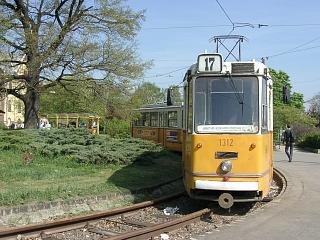
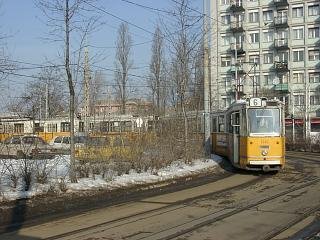
Single Ganz articulated car on
route 17, and a double-set which was only used on the Grand Boulevard routes
4 and 6
These characteristic articulated cars were designed in the mid-1960's. Although we like to refer to this vehicle simply as "the Ganz", this is not really correct, as most of the older Budapest tram types were also built by Ganz Syndicate. We also call it "industrial articulated" because before it came out, there was another type - built by the tram company FVV itself - that was nicknamed "home-made articulated". IMHO this is not the best of tram types ever built: it has a number of flaws which - combined with a bit of under-maintenance - result in a bouncy and noisy riding. Despite this, they can be found on prominent routes like 2.
Routes: 2, 24, 47, 49, 50, 52 + sometimes on 4 in double-sets
Depots: Budafok, Kelenföld, Ferencváros
![]()
KCSV7 - the modernised Ganz cars
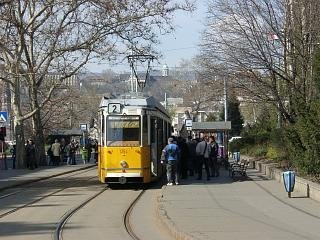
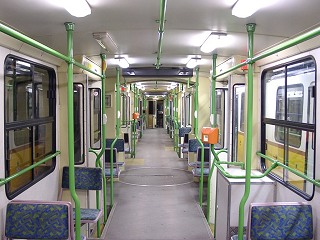
During the modernisation the whole
car body was rebuilt, but the trucks and motors remained
Thirty Ganz articulated cars were modernised by Ganz Ansaldo between 1996 and '99. They received a modern traction control system with an Ansaldo chopper, and their bodies were also rebuilt - unfortunately without major modifications, so the high floor level and the bouncy riding quality remained.
Routes: 2/2A, 17, 24
Depot: Ferencváros
![]()
Tatra T5C5 (being modernised into T5C5K2)
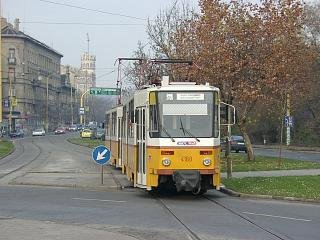
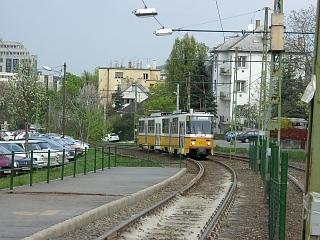
The largest batch of one type ever
bought after the UV: the CKD Tatra T5C5
BKV has made bad experiences with Ganz-MÁVAG in the seventies: the shipment of the Ganz articulated series was delayed so badly, that in 1978 they decided to try something new by buying new trams from a foreign company, namely CKD Tatra in Czechoslovakia. Two test cars were brought in from Brno: T3 number 1583 and K2 number 1013. BKV was not satisfied with these, so CKD designed a tram specially for Budapest: the T5C5. Although its look was based on the experimental T5A5 and the KT4, its electric system is different to the other Tatras: it's the old contactor-switched thing with microprocessor control, driven with a push-pull lever instead of a foot switch.
I think it should be said that buying 4-axle tramcars (instead of articulated cars) in 1980-84 was a step back, but the whole thing was ment as a temporary solution to quickly replace all two-axle motorcars. Interesting is the car body width of 2.5 meters, which necessitated a number of modifications in the tram network. There are still routes where Tatras are not allowed, e.g. route 19 and 2 past the narrow Chain Bridge underpasses!
In 2014 BKV has started to modernise all T5C5 cars, pretty much like the T5C5K ten years earlier, only with current (contemporary) components. The goal is to have all normal (contactors+resistors) Tatras upgraded with modern traction and control equipment (IGBT chopper, CAN-bus) and refurbished interior. Some people call these rebuilt cars T5C5K2M or T5C5K3, but officially they're treated as a T5C5K2 as they're compatible with those. The upgrade program seems to be somewhat slow, I don't know when it will be complete.
Routes: 1/1A, 12, 14,
18, 19, 28/28A, 41 and sometimes on T5C5K lines
as replacement
Depots: Angyalföld, Baross, Budafok
![]()
Tatra T5C5K - the modernised Tatras (now T5C5K2)

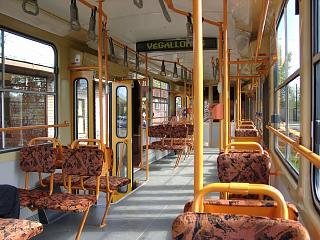
Matrix route display over the windshield
and warm colors inside: the refurbished Tatras
Eighty T5C5 cars were rebuilt in 2003-2004 by the BKV tram workshop and Ganz-Transelektro. They received a modern traction system, but you will more likely to recognise them by the dot-matrix destination displays on the front and the different interior colors. During their grand rehaul starting from 2010 the cars received several minor modifications, so their official designation was changed to T5C5K2.
Routes: 59, 61
and 18 (partially)
Depot: Angyalföld, Szépilona
![]()
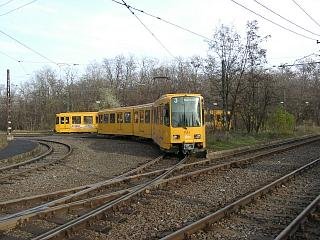

"Stadtbahn" used as a normal tram:
the ex-Hannover cars only run on outskirt routes
Altough polictical struggles between the two governing parties have almost blocked these vehicles coming to Hungary, they're here, and although most of their assets (speed, high floor level to be used with high platforms for fast boarding) are still left unused, they blended nicely into the city's landscape. Their arrival also started a big wave of UV disposal, so the average age of the rolling stock decreased. Their main area of deployment is route 3, a not quite complete outer "tram ring" launched with these vehicles in 2001 as the contraction of route 13 and 63. Since the Zugló depot was fully converted from UV to TW6000 operation, they can also be seen on route 69 and route 3's insection service route 62.
Routes: 3, partially 28, 37, 42, 50, 51, 52,
62/62A, 69
Depot: Száva, Zugló, Ferencváros
![]()
Combino "Plus" or "Supra NF12B"
Siemens has won the call for tender for the new Grand Boulevard trams (routes 4 and 6) with a construction based on the Düsseldorf NF10 trams, which were basically Combinos with small-wheel bogies at the front and back. After the structural problems of the original Combino design became known, Siemens came up with a new design which was accepted by the City Council and BKV. The new type, sometimes called "Combino Plus", but sometimes also "Combino Supra" hasn't got much to do with the original Combinos: instead of a multi-articulated vehicle made out of aluminium, and with rigid trucks, this one is made out of stainless steel, and has bogies.
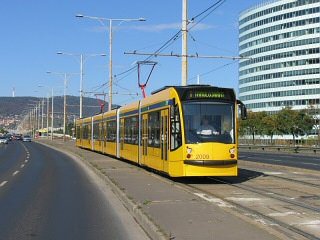
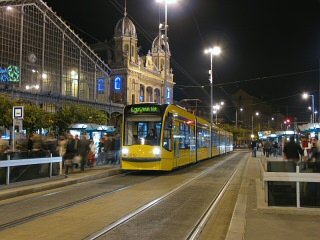
Combino "driving school" (driver
training) on route 1, and another one in passenger service, in front of the
Nyugati pályaudvar (Western Station).
The first car arrived on March 14. 2006, and was taken into revenue usage on July 1 of the same year, after many months of compulsory trial runs. The last one arrived on May 4, 2007. Currently all forty cars are assigned to the Grand Boulevard routes, but there are plans to run them on route 1 on weekends. The whole series consists of forty 54-meter-long, 100% low-floor cars, the longest tramcars in the world for a while (and now challeged by the new CAF units). Due to the nature of the Grand Boulevard (=immense passenger loads even at intervals of 1.5 minutes), they are meant as "standee cars", with buffer areas at the doors and less seats than in other modern designs.
Routes: 4, 6
Depot: Hungária
![]()
After intense competition, the tender started in 2013 was won by Construcciones y Auxiliar de Ferrocarriles, who shipped the first of their 34-meter trams for Budapest in early 2015. After the compulsory tests the first cars entered passenger traffic in September.
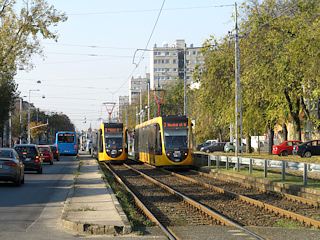
The "short CAF" being tested (left) and in operation (right)
There should be 35 of these trams by May 2016. This means there won't be any "CAF-only" tram lines, rather they will provide low-floor runnings among traditional (high-floor) units.
Routes: 3, 17, 19
Depot: Száva
![]()
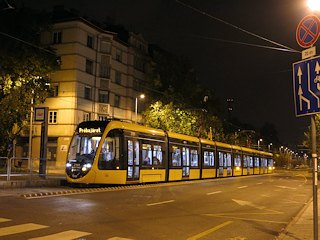
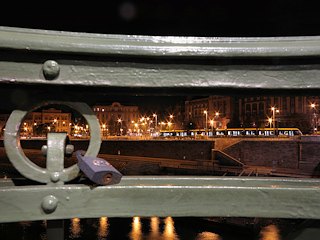
The long beast on a nightly trial run
A longer version of the CAF trams (12 cars in total) should enter revenue operation on route 1 in early 2016. Due to its excessive length (it's longer than the Combinos!), it's not planned to use these vehicles on any other services.
Routes: 1 (planned in 2016)
Depot: Hungária
![]()
They have been built in 1927, and they're still indispensable: the small electric locos with the wooden car body. When they were built, BSzKRt has had on one hand massive freight traffic on its tram network, on the other hand lots of company-internal transports, too. When the city council stopped freight transports on the tram and interurban network in 1996, the territory of these boxy vehicles shrank significally, but they're still regularily used for the transportation of refurbished bogies, current collectors, motors, etc between depots, for hauling rails to the sites of track renewals, and for the transportation of damaged or disposed trams. Two out of the six existing Mukis (7033, 7038, 7039, 7040, 7045, 7061) bear an all-over advertisment for the newspaper "metro". An interesting feature of the Mukis is the warning whistle operated with compressed air: if you hear it, you'll know right away what's coming!
Depot: Ferencváros
![]()
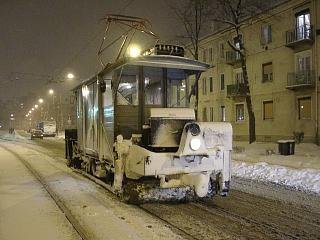
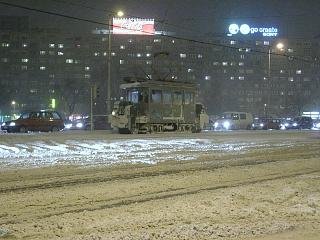
Snow-sweeping trams are a rare
sight
Probably one of the most interesting tram type in Budapest is the snow sweeper with its rotating brushes. Most of these works cars have been converted from ordinary Mukis in the 1950's, although there were four that were built out of the predecessors of the Mukis, namely four tram locos of the company BVVV built in 1910; and there's number 7117, which was built newly in 1965 with a metal car body. As you guess, these cars spend most of their lives hiding in depots, but you might see them in the summer, too, when driving courses for trams with pneumatic brakes takes place: since the snow sweepers have pneumatic brakes, they're the preferred learning vehicles!
Depots: there's one snowsweeper assigned for every depot, with ocassional regroupings for the summertime
![]()
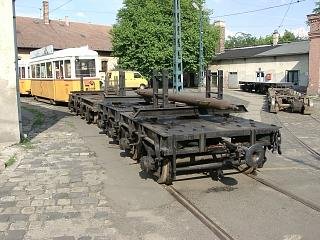
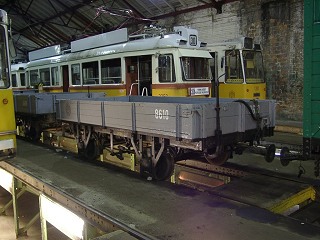
Rail transporter and wagon: only
used for internal transports
As I mentioned earlier, you won't see freight trains with goods wagons or tank cars on the tram network anymore, but you might see some of BKV's special vehicles for internal transports: flat cars, small wagons (built on the frames of the earliest tramcars!) and rail transporters towed by Mukis.
Depot: Ferencváros
![]()
Next page:
A clickable imagemap of the lines
Back to the top
Back
to the index
Disclaimer: The author cannot
be held responsible for mistakes, misinterpretations, inaccuracies, inactualities,
etc. on/of these pages, nor for the content of other pages linked in.
![]()
Send
a mail to the author
The
author's homepage